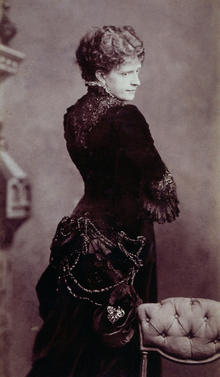Maria Pia of Savoy
| Maria Pia of Savoy | |||||
|---|---|---|---|---|---|

Maria Pia of Savoy, Queen of Portugal;
João Francisco Camacho, c. 1880. |
|||||
| Queen consort of Portugal | |||||
| Tenure | 6 October 1862 – 19 October 1889 | ||||
| Born | 16 October 1847 Royal Palace, Turin, Sardinia |
||||
| Died | 5 July 1911 (aged 63) Stupinigi, Nichelino, Italy |
||||
| Burial | Royal Basilica, Turin, Italy | ||||
| Spouse | Luís I of Portugal | ||||
| Issue |
Carlos I of Portugal Infante Afonso, Duke of Porto |
||||
|
|||||
| House | Savoy | ||||
| Father | Victor Emmanuel II of Italy | ||||
| Mother | Adelaide of Austria | ||||
| Religion | Roman Catholicism | ||||
| Signature | |||||
| Full name | |
|---|---|
| Maria Pia di Savoia |
Dona Maria Pia of Savoy (16 October 1847 – 5 July 1911) was a Portuguese Queen consort, spouse of King Luís I of Portugal. On the day of her baptism, Pope Pius IX, her godfather, gave her a Golden Rose. Maria Pia was married to Luís on the 6 October 1862 in Lisbon. She was the grand mistress of the Order of Saint Isabel.
Maria Pia was the daughter of Victor Emmanuel II, the first King of Italy, by his wife Adelaide of Austria. Her sister Maria Clotilde was the "princesse Napoléon" as wife of Napoléon Joseph Charles Paul Bonaparte and her brothers were King Umberto I of Italy and King Amadeo of Spain.
As Queen, Maria Pia was considered by some as extravagant, but far more for her many charitable works in aid of the Portuguese people. She was known by the Portuguese people as an "angel of charity" and "mother of the poor" for her compassion and work on social causes. At a masquerade ball in 1865, she changed her costume three times. When the Portuguese parliament discussed her expenses, she replied saying "if you want a Queen, you have to pay for her". As Queen, she was largely responsible for the interiors of the Ajuda Royal Palace in Lisbon, still used to this time for banquets during state visits by foreign heads of state.
Maria Pia did not involve herself in politics, but at a conflict with João Carlos Saldanha de Oliveira Daun, 1st Duke of Saldanha in 1870, she stated: "If I were the king, I would have you shot!"
King Luís died on 19 October 1889 and Maria Pia became Queen Dowager. She remained very active and continued with her social projects while holding a dominating position at court. She served as regent during the absence of the king and queen abroad. The Queen Dowager was devastated after the assassination of her son King Carlos I of Portugal and grandson Crown Prince Luís Filipe, Duke of Braganza, on 1 February 1908 on the Praça do Comércio in Lisbon. During her last years in Portugal, she withdrew from the public eye. She was deeply saddened after the military coup that deposed her remaining grandson, King Manuel II of Portugal by the 5 October 1910 Revolution.
...
Wikipedia
